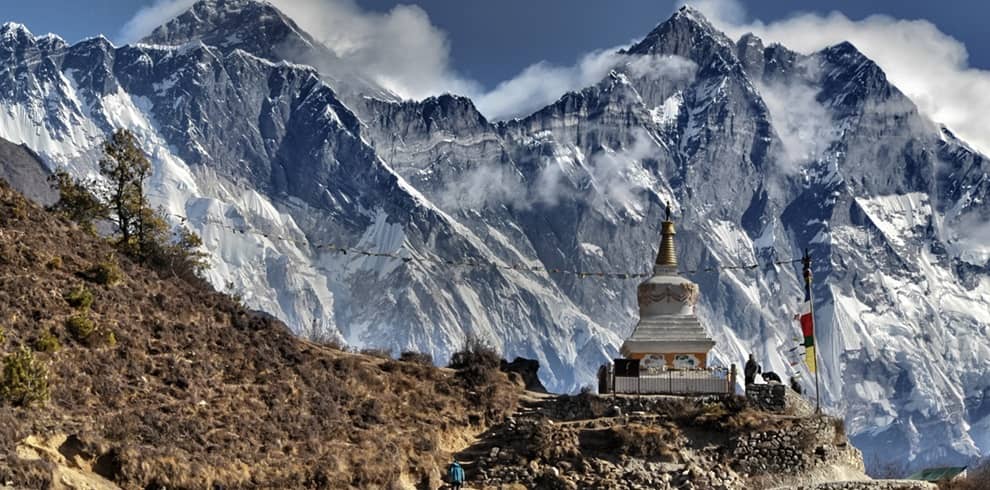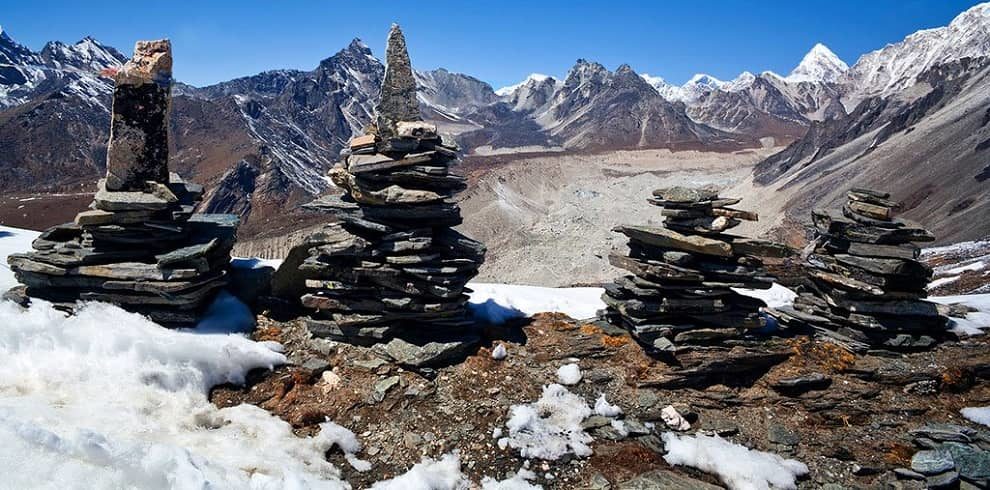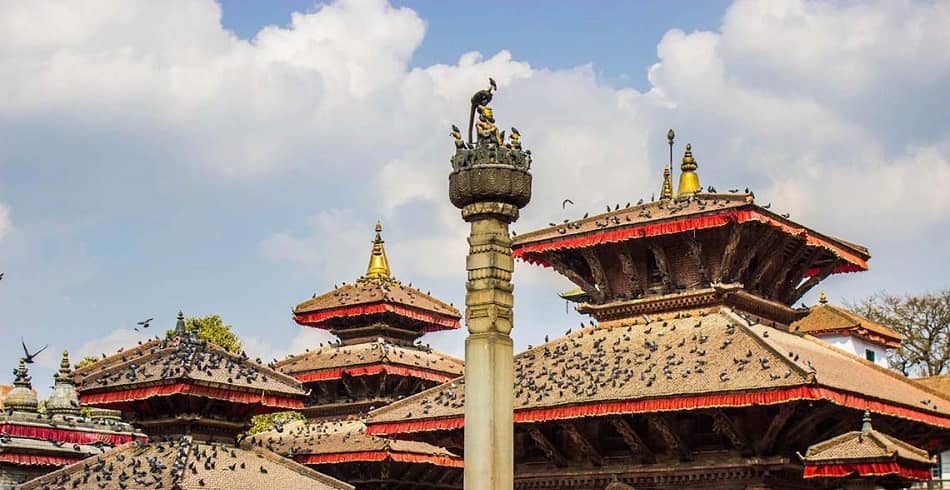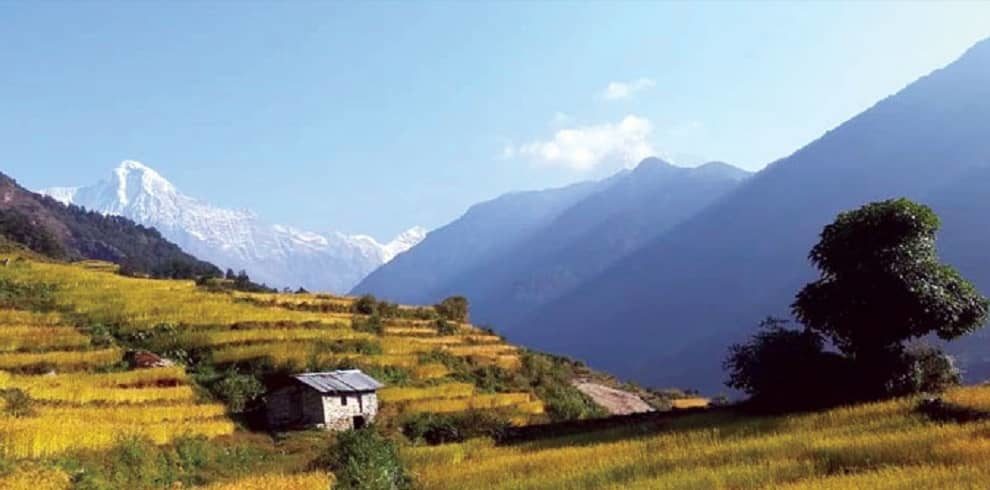Introduction To Annapurna Trek In Nepal
The Annapurna Trek, one of the world’s classic treks, is known for its diverse environment and way of life.
From subtropical trees and the world’s deepest river to high mountain passes, cliffs, and mountain views, the culture and surroundings change dramatically.
Annapurna Circuit encompasses the exhilarating high pass of Thorung La (5,416m/17,769ft) and the deepest Kaligandaki valley inside the Annapurna area.
Annapurna Circuit trek is one of the most popular trails because of its comprehensive splendor, which includes Poonhill, Muktinath Temple, and the amazing hot spring in Tatopani.
We’ll go from 800m to 5416m above sea level, passing through numerous climatic zones such as rice paddy fields, subtropical woodlands, rural farming, and glacial zones. Mt. Dhaulagiri (8,167 meters), Mt. Annapurna I (8,091 meters), Mt. Annapurna II (7,937 meters), Mt. Annapurna III (7,555 meters), Mt. Annapurna IV (7,525 meters), Mt. Annapurna south (7,219 meters), Mt. Manaslu (8,163 meters), Mt. Nilgiri (7,041 meters), Mt. (7,134m).
We also have the chance to learn about the Tibetan way of life, which is prevalent in the Mustang valley. Along with Blue Sheep, there’s a chance of witnessing a Snow Leopard at Yak Kharka. We’ll also stop at Tatopani, where we’ll be able to rest in the area’s famous hot springs.
After a magnificent drive from Kathmandu, the trek to the Annapurna circuit begins at Bhulbhule (8,45m), following the trail towards Jagat (1,300m).
We continue on to Chame through Dharapani (1,860m) (2,610m). Following the Marsyangdi River valley, we follow the trek to Pisang (3,115m).
We hike to Manang (3,540m), where we will rest and acclimate before climbing the Thorung La Pass (17,769ft). Hiking to higher elevations has a basic rule: trek high and sleep low.
We proceed on the trail from Manang to Yak Kharka (4,050m). We climb up to Thorong Phedi the next day (4,525m).
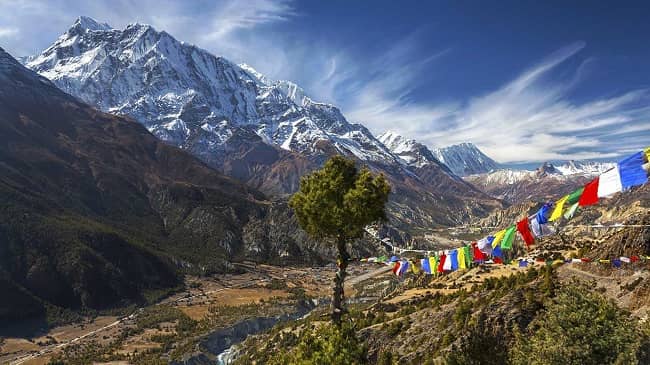
We ascend from Thorong Phedi to Thorong La Pass (5,416m). We descend to Muktinath (3760m), a sacred Hindu and Buddhist pilgrimage site, after crossing cross the Thorong La pass. We climb back to Kagbeni from Muktinath (2,804m). From Marpha, we travel to Ghasa (2,113m) (2,665m).
The walk is even more interesting now that we’ve returned from a new path. We unwind in Tatopani’s (1,200m) hot spring, allowing our muscles to recover from the exertion of the walk. We trek from Ghorepani (2,860m) to Poon Hill (3210m) for a final view of the mountains. The trail is culturally diverse, and each day will be a new adventure for us. We will return to Pokhara from Nayapul (1,050m), where we will spend the night.
Pokhara is a city of delights and a wonderful spot to unwind after an incredible journey. After weeks of walking, there are numerous massage establishments that we can visit. We return from Pokhara to Kathmandu and say the country farewell with a memory we will treasure for the rest of our life.
This Annapurna circuit trek itinerary is designed for trekkers who want to take a more challenging adventure in Nepal’s Himalayas and see the Annapurna circuit’s diverse landscape, topography, and climate zones. Other fascinating trek packages in the Annapurna region are available.
It is a reminder to all of our valued clients who are joining us on the Annapurna Circuit Trek that our journey will begin with a 7-8 hour local bus ride from Kathmandu to Besisahar or Bhulbhule (approx 172.9 km), which is included in the package; however, you can book a Private Jeep for an additional cost, and on the way back to Kathmandu, if you want to take a domestic flight from Pokhara to Kathmandu (20 minutes app Besishar, although being the starting point for Annapurna Circuit Trekking, lacks this facility. To ensure that you attend our Official Briefing as a crucial Pre-meeting, Discovery World Trekking recommends that all of our valued clients come to Kathmandu a day earlier in the afternoon before the day we start our Annapurna Circuit Trek the next day. We do this because we want to ensure that you receive sufficient mental advice and required knowledge, as well as a recheck of equipment and items for the voyage so that if you forget something, we can offer it to you as soon as possible.
Highlights Of Annapurna Trek In Nepal
- Witness the splendor of Nepal’s alpine region.
- ExGorge yak meadows with grazing yaks experience the beauty of Nepal’s alpine area
- Tatopani’s relaxing hot spring
- Stay at the stunningly gorgeous Jomsom, the Mustang district’s headquarters town.
- Spend a day in Pokhara, Nepal’s most exciting city.
- Mount Annapurna, Thorung Peak, Nilgiri, Chulu West and East, Tukuche Peak, Dhaulagiri, Lamjung Himal, Annapurna II, and Annapurna IV are all visible from here.
- Glaciers, gorges, and waterfalls abound.
- Take a tour of the historic Muktinath temple, which is revered by Hindus and Buddhists alike.
- Visit the picturesque Manang neighborhood and bask in its splendor.
- Visit the Barge Monastery, Manang’s largest monastery.
- Traveling via the Thorong La Pass, the world’s largest pass (5,416m)
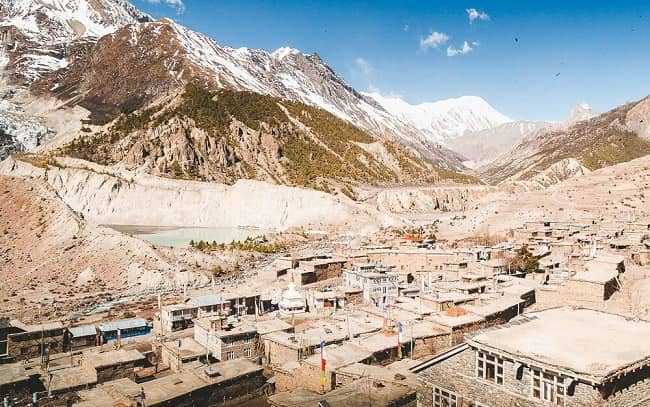
Equipment Checklist
It is recommended to carry the basic clothing and accessories needed for the trek. The following belongings are suggested that should be brought, although we understand that our clients have their own preference for clothing, we have listed some useful clothing during the trek.
Porters will be carrying the main luggage, which should not exceed more than 18kg (one porter will carry two people’s luggage, 9 kg for each). Equipment can be bought in Kathmandu at a reasonable price.
Head
- Scarf or hat for the sun
- Winter hat, insulating hat, or a hat with a wide brim
- Extra batteries for the headlight
Face
- Sunscreen
- Sunglasses that block UV rays
- Wipes for the face and body
Hands
-
Lightweight gloves
-
Heavyweight winter gloves
Body
- Shirts for hiking
- Shirt with a long sleeve made of synthetic fiber.
- Rain jacket with hood
- Jacket made of fleece
- Cotton pants that are light and airy.
- T-shirt (bring lightweight wool)
- Underwear made of polypropylene
- Jacket with down feathers (available for rent in Kathmandu)
- Sweater
- Jacket and pants that are waterproof
Footwear
- Boots for Hiking
- Socks made of thick wool (Take an extra pair of thick light socks)
Essential gear
- A daypack or a backpack (Size depends on whether you take a porter or not)
- Bottle with a heating element
- Purification of water
- Pole for hiking
- Bag for sleeping (-15 degree bag is best for high altitude trekking)
Toiletries
- a drying towel of medium size
- Toothbrush
- Toothpaste
- Deodorant/floss/toilet paper
- Biodegradable soap in a bar
- a pair of nail clippers
- Mirror, little
Personal accessories
-
Money
-
Watch
-
Cell phone
-
Camera
Extra items
- Kit for first aid
- Extra passport pictures and passport photocopies
- Pencil and notebook
- Binoculars
The beginning of the journey toward Annapurna Circuit Trek
The first day in Nepal is your arrival day. The second day is devoted to a full-day sightseeing trip of world-renowned landmarks.
After the tour, we’ll perform a trek briefing, guide introduction, and equipment checklist in the evening. The package includes a three-star hotel in Kathmandu with breakfast.
On the third day, we’ll take local transportation to Bhulbhule through Besisahar to begin the journey.
The package includes local transportation (from Kathmandu to Bhulbhule). A private jeep is available for an additional fee.
Don’t Worry, We’ll Pick You up!
For clients who have bought the trek package, we provide free airport arrival and departure transfers on any airline. A leaflet with your name and our firm name will be held by our agent.
They will greet you with a khada or marigold garland before transporting you to your accommodation in a private vehicle
Accommodation During The Trek
The package includes lodging for the duration of the hike, as well as three nights in a hotel in Kathmandu and one night in Pokhara.
Teahouses, which are essentially hotels with a more domestic vibe, provide lodging along the walk.
They are run by locals and offer all of the essential amenities, including hot showers for a modest fee. Simple but comfortable rooms with two beds, mattress covers, and pillows are the norm.
Some rooms will have their own bathroom, but the majority will share a bathroom with a squat toilet.
You will get the opportunity to interact with local service providers and enjoy the famed Nepalese hospitality.
We have good public ties with local service providers on the Annapurna trip. The organization ensures that the accommodations have been planned ahead of time.
Kathmandu and Pokhara are two of the most beautiful cities in Nepal.
Hot showers and Wi-Fi will be provided for an additional fee in some locations.
The Meals
Because the trek takes place at higher heights, your body will require sufficient carbohydrates, protein, and nutrition in order to go on such massive Himalayan trails.
The food on this walk is quite convenient, unlike in cities, and we make sure you get all of the nutrients you need throughout your trek.
Throughout the walk, you will be served 19 breakfasts, 16 lunches, and 16 dinners.
The following are some examples of typical food menus:
Oatmeal, Corn Flakes, and French Toast with Jam, Butter, Cheese, and Honey are among the nine breakfast options. Tibetan bread, often known as Chapati, is made from local tsampa porridge.
Hashed brown eggs, different types of eggs (omelets, poached, boiled), pancakes, muesli, bread, fruits and vegetables, hot beverages such as tea and coffee, hot chocolates, and so on
Sixteen Lunch – Typical Nepali dishes (Dal, Bhat, and Tarkari), Tibetan Bread, Various Soups, Sherpa Stew, Steaks, Sandwiches, Momo (dumplings), Macaroni, Tenduk, Spaghetti Noodles, Thukpa, Pasta, Vegetable curry, Potato items, Vegetable and Salad, Pizza (Tomato, Mushroom, Mixed), Snacks (Papad, Pra
Dal, Bhat, and Tarkari, Tibetan Bread, Various Soups, Sherpa Stew, Steaks, Sandwiches, and Momo are among the sixteen dinners available (dumplings) Macaroni, Tenduk, Spaghetti, Noodles, Thukpa, Pasta, Vegetable Curry, Potato Items, Vegetable and Salad, Macaroni, Tenduk, Spaghetti, Noodles, Thukpa, Pasta, Vegetable Curry, Potato Items, Vegetable and Salad During the walk, the menu includes pizza (tomato, mushroom, mixed), snacks (papad, prawn), Korean Noodles Ramen, desserts (rice pudding, apple pie), hard drinks, and more.
Fresh, sanitary, tasty, and nutritious food products are frequently available on the menu. The menu is a mix of traditional and regional; Asian and Western food; practically everywhere, but the menu list shrinks as we get closer. At high altitude, we strongly advise drinking plenty of water, green tea, lemon tea, hot lemon, ginger tea, and garlic soup (must), as well as eating plenty of fresh vegetables.
Though there will be lots of non-vegetarian options, we will not recommend any of them because the meat in such locations may not be healthy for the hike. Experts recommend avoiding alcohol, caffeinated drinks, hot cocoa, dairy, and cheesy foods on such high-altitude treks.
Note: The Company will not give lunch or dinner in Pokhara.
All personal bills (alcohol drinks, hot and cold drinks) in tea houses/ lodges or cafes are excluded from the package, save for the usual meals mentioned (breakfast, lunch, and dinner with seasonal fruits).
What is the best time for the Trek?
The most crucial element to consider for this Trek is the weather. The Annapurna circuit attracts trekkers all year, although there are ups and downs as the seasons change.
Spring and autumn are ideal seasons for gentler hikes. From sunrise to sunset, the skies are bright and there is no rain, allowing you to take in the breathtaking views.
The winters are chilly in the hiking regions, with snowfalls, while the monsoon season brings a lot of rain. Trekking during these seasons is therefore difficult but not impossible. In fact, some hikers look forward to taking on these hurdles.
Based on seasons, here is a thorough breakdown of the trial circumstances, which were mostly at high elevations.
March-May (Spring)
The weather is pleasant, the rainfall is light, and the trekking conditions are ideal during this season. The average daily temperature in these regions’ high elevations ranges from 8 to 0 degrees Celsius. Because the lower trip parts are warmer, the hike is rather pleasant.
After March, the hiking season begins. The trek trails are covered in crimson, pink, and white rhododendron blooms by April at elevations above 3,000 meters.
From mid-March until mid-May, the temperature begins to rise. The weather is pleasant, the skies are clear, and the mountains are seen in all their glory.
June to August (Summer)
If you want to hike the Annapurna Circuit between June and August, you’ll be doing so during the summer, when the weather is hot. However, because the monsoon coincides with summer, you must be extra cautious while trekking because the terrain may be wet and slick.
The monsoon season usually starts at the end of June and lasts until the second week of August. The temperature fluctuates from 10 to 23°C during the day and drops to 5°C to 10°C at night. The mornings are normally clear, with clouds forming in the afternoon and then dissipating at night.
Though the rain may pose some issues, a variety of plants bloom throughout this season, making the valleys appear green and distinct from other seasons.
September to November (Autumn)
Autumn (September, October, and November), like Spring, is a popular season for trekkers from all over the world. Autumn is a great time to go hiking because of the moderate temperatures, light winds, and low precipitation.
The sun shines brilliantly, the day temperature is ideal for trekking, the sky is clear, and you have a spectacular view of the mountains during this season. Furthermore, you will be treated to stunning starry skies.
By early September, the monsoons will have passed, and the weather will be mild to warm. In high altitudes, daytime temperatures can reach up to 20°C, while nighttime temperatures can drop to as low as 5°C.
The monsoon greens fade to golden/amber, creating a stunning contrast against the crystal blue skies, and the grains in the fields are ripening. The lowlands are lush and the environment is clean. Dashain and Tihar, Nepal’s two most important festivals, also fall during these months.
December to February (Winter)
The Annapurna region’s winter treks are just as popular as the region’s spring and autumn treks. While some portions of the Annapurna region are frigid at this time of year, many trekkers are excited. The Annapurna Circuit can be as cold as -10 degrees Celsius.
The Annapurna region’s coldest season begins in December and lasts until early February. The weather steadily warms in late February. The sun makes it feel warmer during the day. Despite the cold, the skies are frequently clear, and the snow-capped mountain views are breathtaking.
It’s the time of year when the trails are the least congested. This season may not be ideal for novice trekkers, but experienced trekkers should have no trouble.
The weather in the Himalayas (at high altitudes) is erratic, and temperatures fluctuate rapidly.
Acclimatization
Our 20-day Annapurna trekking program includes a rest day in Manang, at 3540 meters, to allow for adequate acclimatization.
There is a substantial risk of altitude sickness, also known as acute mountain sickness, at this height. Although altitude sickness is preventable, ignoring its symptoms can result in a life-threatening condition.
Starting at Bhulbhule 845 m and trekking for four to five days in low elevation before reaching Manang 3540 m gives our bodies enough time to adjust to the high altitude environment and reduces the risk of altitude sickness.
We use oximeters to monitor your oxygen level and detect symptoms, and our trekking leaders and guides have significant first aid training and experience in the Himalayas.
We ensure that your health is in good hands. Precautions will be suggested by your hike leader or guide. The ideal strategy is to take it slowly and drink at least 4 liters of water every day. If altitude sickness is severe, the only treatment is to descend promptly.
Please keep in mind that your group leader has the final say on whether or not to continue climbing based on your general health. It’s critical to remember that some people are more vulnerable than others.
Trip Grade: Fitness level, Medical, and Health
With the crossing of the 5416m Thorong La Pass, the 20-day Annapurna Trek is a challenge. Depending on the destination and the number of steps we take, the walk takes between 4 and 7 hours per day. With rugged and stone-paved trails, the trek is largely uphill or in severe descents.
It is not impossible for a typical person to participate in these treks, but being healthy and exercising regularly will make the walk more comfortable and enjoyable. A trekker’s previous trek experience, as well as regular exercise and yoga, is a benefit. Furthermore, if you enjoy trekking, you may make it happen and achieve your goals.
This walk, on the other hand, is not recommended for people who have certain medical concerns, such as heart or lung disease. Because the majority of the walk includes moderate to difficult climbing, it could be hazardous to their health. Before attempting this expedition, we urge that you speak with your doctor.
In addition, we ensure that you have all of the necessary medical kit supplies for the walk.
Group trek | Private & Solo Treks
We organize both group and private treks. Group discounts are available dependent on the size of your group. The larger your group, the greater the savings. Please see our price list for further information. Simply click the – we offer group discounts – link on the right.
We can accommodate any group size. For groups of 12 or more, there will be a guide, a porter for every two trekkers, and an assistant guide.
A typical day on the trek
Every day will bring a new adventure of trekking, climbing, admiring the landscape, taking photographs, and discovering the local villages.
During the adventure, an experienced, pleasant, and trained expert Sherpa will join us on the hike and give information and historical details about the locations.
We shall be accompanied by the porters who will be carrying our bags. We will, however, be carrying our own modest bag containing all of the necessary materials.
The day begins with a nice cup of tea or coffee in the morning. We set off on the day’s walk from 7 AM to 8 AM, depending on the duration and nature of the day’s trek, after packing our bags and eating a hearty breakfast.
We will take lunch about midday on the way to the next destination after hiking for three to four hours, and we will continue after roughly an hour of respite.
The trek in the afternoon is usually shorter, lasting two to three hours. We nibble on the additional dietary food once we arrive at our overnight lodge/tea house/tent. We’ll also get some free time to go exploring the area.
Dinner is served between 6 and 7 p.m. We will spend some valuable time in friendly chats before retiring to bed, discussing the events of the day. The expedition leader/guide will give us an overview of the next day’s activities.
Following the briefing, we play onboard games like monopoly and cards, as well as watch climbing documentaries that are available. Most visitors learn the Nepalese language in a light and enjoyable manner from our personnel or read books before retiring to their beds for a well-deserved rest.
Communication on trek
The usage of internet connectivity will be offered at the lodges on the Annapurna Circuit Trek for an additional fee. You can contact your family and friends through the lodges, however, communication will be done through the phone after we reach high elevations for safety reasons.
We’ll check in with all of our valued clients via our leader at least once a day to make sure they’re okay, safe, and have all they need. During the trek, you’ll always be linked to the DWT office in Kathmandu if you need assistance.
Also, depending on the network you choose, there will be a signal before the high altitude, but it will be weak. We may give you a different local sim card (most businesses have wifi service accessible for an additional fee) if you request it for good access to connect.
In most cases, Wi-Fi is available during the walk-in hotels/lodges for an additional fee.
Extra personal expenses for the Trek
In Kathmandu, guests are responsible for arranging their own meals and lodging. The package includes all meals, transport, and lodgings needed for the Trek.
However, lunch and dinner in Pokhara are not included in this package. Pokhara, Nepal’s tourist capital, offers a diverse range of dining options. We invite you to explore the city and eat whatever you like.
Trekkers, too, require funds for visa fees, travel insurance policy purchases, beverages, snacks, tips, and mementos, among other things. We recommend bringing cash (in the form of dollars) and exchanging it for rupees in Kathmandu. You can also withdraw money from ATMs in Kathmandu using your credit or debit card.
Electricity for battery recharge, water requirements
Electricity for camera and mobile battery recharge is offered at an additional fee throughout the Annapurna trip lodges.
Water can be purchased in the form of packed mineral water from local lodges and en route shops, or heated water can be filled at an additional cost from the lodges. Purification pills are provided by Discovery World Trekking to make water drinkable.
We advise against drinking water from rivers, taps, or wells in hiking areas because the water may not be safe to drink.
Information Regarding Travel Insurance
The Thorung La High Pass, at 5,416 meters, is the highest point on this route. This is not a pleasant hike, but rather a strenuous one, with the risk of altitude sickness and other unforeseen catastrophes such as accidents, diseases, floods, landslides, or abrupt climatic changes.
This expedition necessitates the purchase of travel insurance. We require a copy of every trekker’s comprehensive travel insurance policy certificate.
All trekking members must be covered for medical and emergency repatriation, including helicopter rescue and evacuation charges at high elevations.
We can make recommendations for insurance companies based on our clients’ experiences, but we do not sell policies.
Once our valued clients have booked trekking, we strongly urge them to email us their comprehensive insurance information. We shall use the insurance policy and informational materials you supplied us in the event of an emergency. It will assist us in planning a rapid and efficient rescue effort, as well as a transfer for emergency medical assistance.
Please double-check that your insurance policy covers the cost of mountain rescue services at the highest point of your trek.
Trek Safely
We ensure the safety, security, and contentment of our valued customers. We are really concerned about your safety. Here are some of the methods we use to keep you safe.
- We have all of the appropriate gear, equipment, and first-aid supplies with us.
- Our trek leaders have undergone extensive first-aid training.
- Our trek guides have the entire authority to cancel or continue the excursion if someone becomes ill.
- In the event of an emergency, a helicopter will be dispatched for evacuation (covered by insurance).
- The entire walk will be done in a group.
Please check with your travel insurance company to see if they cover helicopter rescue and evacuation up to 6,000 meters. Do not just rely on the information on their website.
Nepal Tourist Visa
Except for Indian nationals, all foreigners must have a valid visa to enter Nepal. At Tribhuvan International Airport and Nepal’s borders with India and Tibet, you can obtain an on-arrival visa. Visit www.immigration.gov.np. for additional details.
You’ll need a passport that’s valid for at least six months, a passport-size photo, and visa fees to apply for a visa. A 30-day visa costs $50 at the moment (to be paid in cash).
A free visa will be given to children under the age of ten. It is strongly recommended that you examine the current regulations. Visa regulations are subject to change at any time. Citizens of China and members of the South Asian Association for Regional Cooperation (SAARC) (Bangladesh, Bhutan, India, Maldives, Pakistan, and Sri Lanka) are exempt from visa fees.
Certain countries’ citizens may be denied a visa upon arrival. On-arrival visas are not available for citizens of Nigeria, Ghana, Zimbabwe, Swaziland, Cameroon, Somalia, Liberia, Ethiopia, Iraq, Palestine, and Afghanistan. If you are a citizen of one of these countries, please contact the Nepalese Embassy in your country.
Before we embark on our journey, we’ll double-check everything (luggage, equipment, etc.) during our briefing.
How Much Luggage Can I take during the Trek?
Your stuff will be carried by porters. Two trekkers will be served by one porter, and the total luggage weight should not exceed 18 kg. As a result, each trekker is limited to 9kg. Our porters are never overworked. We also want you to bring a small backpack with you to protect your valuables and crucial documents.
Money exchange | USD to NPR
Nepali Rupees (NPR/Rs) are the local currency.
(1 USD = ~ Rs.124 NPR).
You can exchange major foreign currencies through local banks and legitimate money exchanges in Kathmandu and all over Thamel. Legitimate money exchanges display their ongoing exchange rates visibly to the public.
Please note – only 100 INR (Indian Rupees) and 2000 INR notes are legal in Nepal.
Despite having the security advantage of traveler’s cheques, we prefer cash exchange. It helps avoid lengthy processes and high bank commissions.
You can withdraw cash (in Rupees)from ATMs all over Kathmandu and Thamel itself. Many of these ATMs are open around the clock. The maximum withdrawal amount is 35,000 Rupees for a 500 Rupees processing fee for foreign cards.
If you use the money exchange facilities at banks and financial institutions, they impose a service charge fee of about 4% or more.
During the trek, there are no banks and money exchange services so you should exchange your money in Kathmandu, depending on how much personal expense you require. Only Nepali Rupee is accepted in trekking regions.
Most established banks in Asia will only accept foreign currency notes that are not old, torn, or faded. Please ensure that you have new, clean notes.
Traveling Responsibly
We are firm believers in environmentally responsible tourism. As a result, we collaborate with the Kathmandu Environmental Education Project (KEEP) to create environmentally sustainable treks that benefit both trekkers and communities in the trekking areas.
Our Trekking Team
Our knowledgeable guide/Sherpa will accompany us on the trek to ensure your safety and comfort. Your stuff will be carried by porters.
Our members are locals from high Himalayan remote places, and they have exceptional physical endurance at high altitudes.
We value all of our employees, so we pay them well and take care of their insurance, clothing, food, and lodging throughout the trip. When our guides and porters become unwell or injured, they receive medical attention.
Only happy people can make others happy, thus we always make sure that our team members are happy. Members of our trek/expedition team have the following qualifications:
- Authorized Trekking Guide Training Certificate
- Intensive Wilderness First Aid Training
- Fluency in English and another major language
- Conservation and Biodiversity Training
- Experience with rock climbing
Tipping in Nepal
Tipping is accepted and respected in Nepali society, and it is a form of expressing thanks. Tipping is at the discretion of hikers and is based on service quality. We recommend tipping at the end of the hike and as a group.
100 % Secure Payment | MasterCard | Visa | American Express| Other Methods
We are a government-approved and bonded trek and tour company in Nepal. We are also members of the Nepal Mountaineering Association (NMA) and the Trekking Agency Association of Nepal (TAAN) (NMA). As a result, you may book your trek/expedition with complete trust.
As a deposit, we require 10% of the total trip cost. Within a week of booking, please send your documentation, including a copy of your passport, passport-size pictures, travel insurance policy, and arrival and departure flight information.
You can make a 10% deposit via bank transfer, western union, or online payment on our website, and the full balance when you arrive in Nepal. Cash, bank transfer, and credit cards are all acceptable methods of payment. In addition, you will receive payment choices in your email.
Last-minute booking on Annapurna Circuit Group Trek | Private Trek
We offer last-minute bookings for individuals who are unable to book Annapurna Circuit Trek in advance. You must pay 100% of the trek cost 24 hours before the trip begins to take advantage of this service.
We make every effort to run last-minute treks/trips on your scheduled date. However, there is a slight potential for a journey delay owing to factors beyond our control, such as terrible weather or a lack of housing.
Trip Extensions
If you have extra days after the trip, you can embark on a sightseeing tour in Kathmandu or the surrounding districts. In Chitwan, you can also embark on a jungle safari, paragliding, rafting, canyoning, or other treks.
Feedback
We offer a farewell meal at the end of the trek, and we will also award you with a trek completion certificate after dinner (hard copy). It’s also a great opportunity to tell us about your experience and provide us feedback.
USEFUL INFO ABOUT ANNAPURNA CIRCUIT SHORT TREK
Please note that the Annapurna Round Trek has set departure dates from Kathmandu and Pokhara, but they can be customized to fit your needs and timetable. Please have a look at the dates we have set for this expedition. If our scheduled departure dates do not work for you, please contact us and we will make arrangements to meet your needs. Please keep in mind that the above itinerary may be changed due to circumstances beyond our control, such as weather or lodging availability. The new itinerary will be created with the group’s best interests in mind. We’ll do everything we can to make sure the modified itinerary is suitable for everyone and does not detract from the overall trip experience.
We look forward to accompanying you on the Annapurna Circuit walk, which will take you through some of the most breathtaking landscapes in the world and provide you with amazing Himalayan panoramas!
You may also visit Bardiya National Park Tour-Cost, Distance, Itinerary, In Nepal – 4 Days
Overview Of Annapurna Trek
- The Annapurna Trek visits culturally-rich Kathmandu Valley (City of Temples) and the Annapurna circuit trail. We travel from Kathmandu to Annapurna.
- Within this range, we shall see the different Nepalese people’s hospitality, the enticing terrain, and the deep woods with floras and faunas. Kathmandu’s ancient alleys and Durbar Squares reveal the country’s history. We follow the clouds to Annapurna and enjoy nature’s serenity.
- Annapurna Circuit Trek is a famous Nepali trek. The trail circles Annapurna Massif, gorgeous rivers, and snow-capped mountains. Deep valleys, uninhabited mountain routes, hot springs, Buddhist and Hindu temples, farming settlements, and a new view of the Annapurna(I-IV) Peaks at every turn. The trail offers a package of surprises with its beauty and locals’ warmth.
